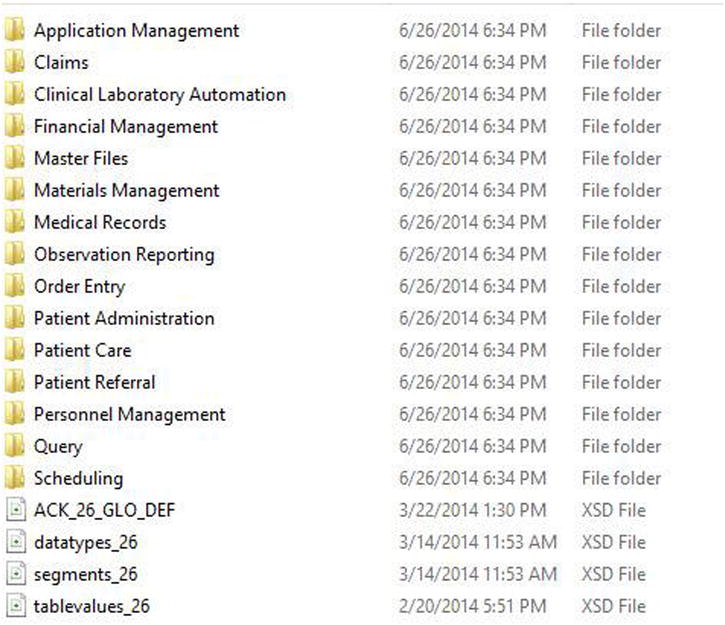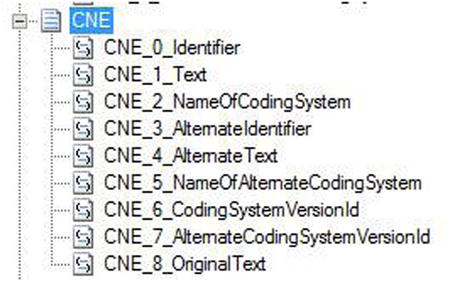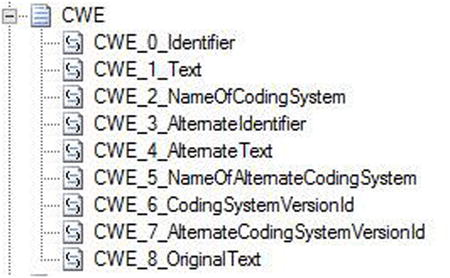![]()
HL7 Version 2.6
The release of Microsoft BizTalk 2013 R2 includes the HL7 Version 2.6 standard.
HL7 Version 2.6
If you compare Version 2.6 to Version 2.5.1, you will find that quite a few new events, segments, and messages have been added. In addition to these, two new chapters have been added to the HL7 Version 2.6 standard. These are Chapter 16 - Claims and Reimbursements and Chapter 17 - Materials Management.
![]() Note Much of the information contained within this appendix is directly from The HL7 Version 2.6 Standard Guide.
Note Much of the information contained within this appendix is directly from The HL7 Version 2.6 Standard Guide.
If you open the folder C:Program Files (x86)Microsoft BizTalk 2013 R2 Accelerator for HL7TemplatesSchemasV2.X2.6, you will see what is included in Version 2.6 (also shown in Figure A4-1).

Figure A4-1. Folder heirarchy for Version 2.6
Differences Between Version 2.6 and 2.5.1
Let’s take a brief look at some of the differences between Version 2.6 and Version 2.5.1.
Three of the Version 2.5.1 data types are affected.
- The CE data type has been removed. It has been replaced with the CNE - Coded with no exceptions and CWE - Coded with Exceptions data types. Figures A4-2 and A4-3 show the components for these data types.

Figure A4-2. CNE components

Figure A4-3. CWE Components
- The TS - Time Stamp data type is no longer used. It was replaced with the DTM data type, which is equal to the TS data type, but without the second component.
- The ED - Encapsulated Data data type uses a new table (table 0834). All the other tables referenced by this data type have been refined. The values contained within this table are a subset of W3C MIME types; audio, image, model, multipart, text, and video.
Segments
Two new segments have been added: UAC - User Authentication and ARV - Access Restrictions.
UAC - User Authentication
The UAC is an optional segment available in all the Version 2.6 messages. This segment provides user authentication credentials for the receiving system. Your choices for credentials are the following:
- Kerberos Service Ticket (http://technet.microsoft.com/en-us/library/bb742516.aspx)
- SAML Assertion (http://en.wikipedia.org/wiki/SAML)
The UAC segment includes two new fields:
- UAC-1 - Credential Type Code, which is a CWE data type
- UAC-2 - User Authentication Credential, which is an ED data type
ARV - Access Restrictions
According to Chapter 3 of The HL7 Version 2.6 Standard Guide, the ARV, which is a new segment, has been added to all the ADT message types. Its main use is to specify access restrictions. Let’s say a person or patient objects to having specific data exposed to family members or friends.
The ARV Segment has six fields. The key fields are ARV-2, which contains the Action Code (Add, Delete, and Update), and the ARV-3 which contains the Access Restriction Value. The ARV-3 is used to identify what information is restricted.
The Mood Code field has been added. The Mood Code is used to specify how the data contained within a particular segment be processed by the receiving system. You will find that the Mood Code field has been added to the following segments; OBX, RXO, PRB, GOL, PTH and PRD.
![]() Tip You can consider the Mood Code as the processing instruction for the segment. It is only allowed in new messages.
Tip You can consider the Mood Code as the processing instruction for the segment. It is only allowed in new messages.
A good example of its use would be if there is an OBX segment in the outbound message. This field can specify if the OBX contains a result, or that the sender expects a result back.
In this sample, the Mood Code field is a CNE data type. These values are contained within the HL7 Version 2.6 - 0725 table. The components of the Mood Code are shown in Listing A4-1.
Listing A4-1. Mood Code Components
<Identifier (ST)> ^ <Text (ST)> ^ <Name of Coding System (ID)> ^ <Alternate Identifier (ST)> ^
<Alternate Text (ST)> ^ <Name of Alternate Coding System (ID)> ^ <Coding System Version ID (ST)> ^ <Alternate Coding System Version ID (ST)> ^ <Original Text (ST)>
Table A4-1 shows some common Mood Codes.
Table A4-1. Mood Codes (Source: HL7 Version 2.6 Standard Guide)
Value |
Description |
|---|---|
APT |
Appointment |
ARQ |
Appointment Request |
EVN |
Event |
EVN,CRT |
Event Criterion |
EXP |
Expectation |
INT |
Intent |
PRMS |
Promise |
PRP |
Proposal |
RQO |
Request-Order |
Besides the values listed in Table A4-1, the 0725 table contains two additional values: “Criterion applying to Eve” and “Eg Use in Care Plans.”
If you are working with veterinary medicine, then the addition of two new message types will be of interest to you. These new message types have been added to the laboratory domain.
- 037: OPL - Population/Location-Based Laboratory Order Message
- 038: OPR - Population/Location-Based Laboratory Order Acknowledgment Message
You can read more about these message types in Chapter 4 of the HL7 Version 2.6 Standard Guide.
Two New Chapters
As previously mentioned, two new chapters have been added. Each chapter provides a new transaction set.
![]() Note There is quite a bit of information contained within these new chapters. We won’t go into too much detail here. If you read the chapters in the HL7 Version 2.6 guide, you will find all you need to know about these new transaction sets.
Note There is quite a bit of information contained within these new chapters. We won’t go into too much detail here. If you read the chapters in the HL7 Version 2.6 guide, you will find all you need to know about these new transaction sets.
Claims and Reimbursements Transaction Set
This transaction set is in Chapter 16 of the HL7 Version 2.6 Guide. It supports the communication of claims information from a provider to payer or reimbursement authority.
![]() Note The Claims and Reimbursements Transaction Set is not used in the United States; HIPAA is used instead.
Note The Claims and Reimbursements Transaction Set is not used in the United States; HIPAA is used instead.
Materials Management Transaction Set
This new transaction set supports supply chain management within a healthcare facility. Two new and distinct topics are covered within this transaction set.
Inventory Item Master File Updates
This topic covers the exchange of common materials-related reference files. This files are also known in HL7 as master files. Eight new segments are related to this topic. Table A4-2 describes these segments.
Table A4-2. Master File Segments
Identifier |
Description |
|---|---|
IIM |
INVENTORY ITEM MASTER SEGMENT |
ITM |
MATERIAL ITEM SEGMENT |
STZ |
STERILIZATION PARAMETER SEGMENT |
VND |
PURCHASING VENDOR SEGMENT |
PKG |
PACKAGING SEGMENT |
PCE |
PATIENT CHARGE COST CENTER EXCEPTION |
IVT |
MATERIAL LOCATION SEGMENT |
ILT |
MATERIAL LOT SEGMENT |
In addition to the segments, two new types have been added. These are Placer Request and Filler Request. You can read about these types in Chapter 17 of The HL7 Version 2.7 Standard Guide.
Sterilization and Decontamination
Sterilization and decontamination cover order-related information for an instrument tracking system and a sterilizer. Four new segments have been added.
- SCP - STERILIZER CONFIGURATION SEGMENT
- SLT - STERILIZATION LOT SEGMENT
- SDD - STERILIZATION DEVICE DATA SEGMENT
- SCD - ANTI-MICROBIAL CYCLE DATA SEGMENT
There are a few more modifications. In Chapter 5 of the HL7 Version 2.6 standard, the query profile has replaced query conformance statements. The reason for this is that the term “query conformance statements” was very misleading.
Query Profile
The guide describes a query profile as
A declaration which sets forth the name of the query supported by the Server, the logical structure of the information queried, and the logical structure of what can be returned.
Chapter 5, page 7 of the of the HL7 Version 2.6 Standard
Removed Message Types
Several query message types that exist in Version 2.5.1 have been removed. These are EQQ - embedded query language query, RQQ - event replay query, SPQ - stored procedure request, and VQQ - virtual table query.
![]() Tip One thing you need to be aware of is that Version 2.6 has increased in size over the previous versions. Many new artifacts have been added. There are well over 300 trigger events and more than 2,000 fields.
Tip One thing you need to be aware of is that Version 2.6 has increased in size over the previous versions. Many new artifacts have been added. There are well over 300 trigger events and more than 2,000 fields.
Summary
As you have seen, HL7 Version 2.6 is very different then Version 2.5.1. If you are planning on using it, then you should review the complete standard. You can download it from www.hl7.org/implement/standards/product_brief.cfm?product_id=145.
